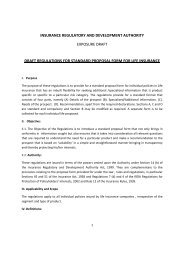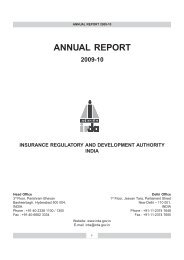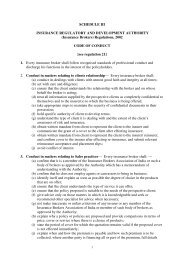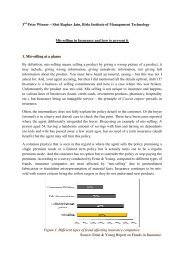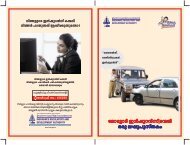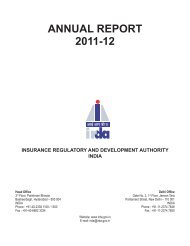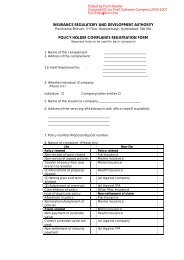'ÃÄ ÃflßĸÄ⧠â¢Ä±âU Ãflâ§Äâ ŽËÄÃÅâ§âUÃ¡Ä - IRDA
'ÃÄ ÃflßĸÄ⧠â¢Ä±âU Ãflâ§Äâ ŽËÄÃÅâ§âUÃ¡Ä - IRDA
'ÃÄ ÃflßĸÄ⧠â¢Ä±âU Ãflâ§Äâ ŽËÄÃÅâ§âUÃ¡Ä - IRDA
You also want an ePaper? Increase the reach of your titles
YUMPU automatically turns print PDFs into web optimized ePapers that Google loves.
in the airExposure DraftRef:Date:21-09-2012irda journal October 2012ToALL LIFE INSURERS and NON-LIFEINSURERSCOMPOSITE PACKAGE OF STANDARDINSURANCE PRODUCT –RURAL & SOCIAL SECTOR1) Objectives and target group:(a) Having regard to the vulnerability ofweaker sections of society and the lackof opportunities in rural India, theParliament had mandated that everyinsurer undertake such percentage oflife insurance and general insurancebusiness in these sectors as may bespecified by the Authority. Theobjective of mandating a minimumpercentage cover to these sectionswas to extend insurance cover to meetexigencies cast by naturalcatastrophes, accidental death inparticular as also as a means ofprotection for the family and somesavings to bolster their financialsecurity.However, the experience shows thatmost of the products on offer aremerely scaled down versions ofproducts which were designed tocater to a different income segment.For instance, a product which wasdesigned to provide life cover, typicallyof a few lakhs of Rupees, was downscaled by reducing cover offered toRs.50,000 with a correspondingreduction in premium in order tomake it more affordable. A similarapproach is noticed even in productswhich offer covers for various namedperils like fire, natural catastrophe,personal accident etc.(b) With this motive, in accordance withthe philosophy underlying section32(b) and section 32(c), the Authorityimposed rural and social sectorobligations to be undertaken by eachinsurer. Further, the <strong>IRDA</strong> came outwith a set of Micro InsuranceRegulation in 2005, which allowedtie-up between life and generalinsurance companies. In order toencourage deeper penetration andreach in these sectors, the Authorityallowed differential treatment interms of commissions andintermediaries in distributing theproduct under micro insurance.(c) Some of the views expressed bystakeholders are enumerated below:Only limited success has beenperceived in this direction and it isnecessary to re-examine whether thecurrent types of policies being offeredmeet fully the underlying objectiveswith which the Parliament hadprovided for Sections 32(b) and 32(c).The figures of performance indicatethat the product sold to meet thetargets prescribed by Regulations inthis regard exhibit very lowpersistency, low claim frequency andlow claim ratio. After due examinationof the situation and discussion withpersons involved in such an activity,the Authority believes that the lowpersistency, claims frequency andclaims ratio was partly because thecommunication mechanism of theprotection offered by an insuranceproduct to a prospect or a policyholderhas not been adequate. It is a widelyacknowledged social truth thatparticularly when dealing withweaker sections and an unletteredgroup of people ‘word to mouth’communication carries far greaterconviction than advertisements.For this type of communication tospread effectively there should be alarge number of persons who havereceived the benefits assured in anyinsurance policy. This again wouldimply that a system must bedeveloped to encourage greaterrelationship between a giveninsurance company and the peoplewho reside in a given geographicalspace. There is tremendous inertiaand slowness in communicationwhich can only be overcome by timeand continued effort. The other pointwhich is perceived is that currently thetypical general insurance productcovers only certain named perils, forinstance, personal accident, loss ofbelongings, natural catastrophes etc.Each of these in particular is a separatepolicy. Similarly death is a separatepolicy. In other words, considering therange of perils and the nature of lifecovered in contingency, the prospectwill be required to acquire manypolicies. Given the clientele which isbeing addressed, it would be moreeffective to have a single policy whichcovers all the above types of perils.Further, such a policy should alsoenable savings and offer a choice to aprospect to purchase a policyaccording to his cash flows and hisperception of needs and capacity topay.However, despite all these effortsplaced by Authority, the performancein this sector is unsatisfactory. The tieupallowed between life and non-lifeinsurers to provide effective means ofcover was not used largely by theinsurers. The experience in the sectoralso reveals that insurance awarenessis very low. This is evident from the lowpersistency figures, low claimsfrequency and low claims ratio.(d) In this background, to promote anddevelop insurance awareness, toprovide a means which would have animpact on improving the standards,provide protection to various risks andto enable them to build a corpus for16



